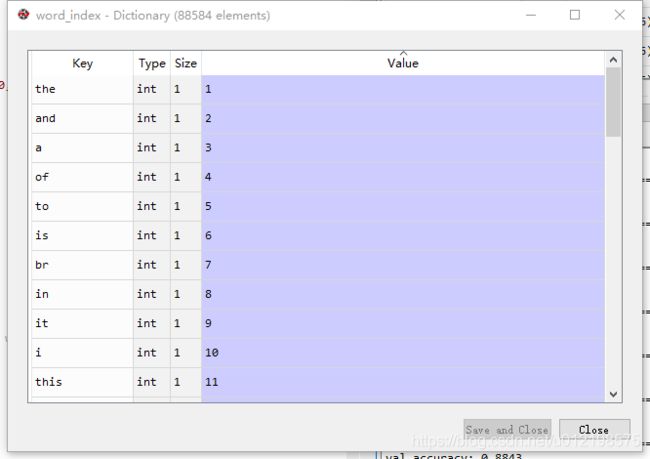tensorflow——lmdb
参考官网:https://www.tensorflow.org/tutorials/keras/basic_text_classification
与源码不同,设置index_from=0从第0位开始,实际上map类型的word_index会从1开始。
import tensorflow as tf
from tensorflow import keras
import numpy as np
imdb = keras.datasets.imdb
(x_train, y_train), (x_test, y_test) = keras.datasets.imdb.load_data(num_words=10000, index_from=0)
print("train len >> %d, test len >> %d" %(len(x_train), len(x_test)))
print(x_train[0]) #每个整数表示字典中的一个特定字词
#将整数转换回字词
# A dictionary mapping words to an integer index
word_index = imdb.get_word_index()
# The first indices are reserved
#word_index = {k:(v+3) for k,v in word_index.items()}
#word_index[""] = 0
#word_index[""] = 1
#word_index[""] = 2 # unknown
#word_index[""] = 3
reverse_word_index = dict([(value, key) for (key, value) in word_index.items()])#将 value和 key反转
def decode_review(text):
return ' '.join([reverse_word_index.get(i, '?') for i in text])
print(decode_review(x_train[0]))
#不够256长度的评语用0补充
x_train = keras.preprocessing.sequence.pad_sequences(x_train,
value=0,
padding='post',
maxlen=256)
x_test = keras.preprocessing.sequence.pad_sequences(x_test,
value=0,
padding='post',
maxlen=256)
# input shape is the vocabulary count used for the movie reviews (10,000 words)
vocab_size = 10000
#模型序列
model = keras.Sequential()
model.add(keras.layers.Embedding(vocab_size, 16))
model.add(keras.layers.GlobalAveragePooling1D())
model.add(keras.layers.Dense(16, activation=tf.nn.relu))
model.add(keras.layers.Dense(1, activation=tf.nn.sigmoid))
model.summary()
model.compile(optimizer=tf.keras.optimizers.Adam(),
loss='binary_crossentropy',
metrics=['accuracy'])
#用训练集的前10000个训练
x_val = x_train[:10000]
partial_x_train = x_train[10000:]
y_val = y_train[:10000]
partial_y_train = y_train[10000:]
history = model.fit(partial_x_train,
partial_y_train,
epochs=40,
batch_size=512,
validation_data=(x_val, y_val),
verbose=1)
results = model.evaluate(x_test, y_test)
print(results)
history_dict = history.history #model.fit() 返回一个History对象,该对象包含一个字典,其中包括训练期间发生的所有情况
history_dict.keys()#dict_keys(['loss', 'val_loss', 'val_accuracy', 'accuracy'])
import matplotlib.pyplot as plt
acc = history.history['accuracy']
val_acc = history.history['val_accuracy']
loss = history.history['loss']
val_loss = history.history['val_loss']
epochs = range(1, len(acc) + 1)
# "bo" is for "blue dot"
plt.plot(epochs, loss, 'bo', label='Training loss')
# b is for "solid blue line"
plt.plot(epochs, val_loss, 'b', label='Validation loss')
plt.title('Training and validation loss')
plt.xlabel('Epochs')
plt.ylabel('Loss')
plt.legend()
plt.show()
plt.clf() # clear figure
acc_values = history_dict['accuracy']
val_acc_values = history_dict['val_accuracy']
plt.plot(epochs, acc, 'bo', label='Training acc')
plt.plot(epochs, val_acc, 'b', label='Validation acc')
plt.title('Training and validation accuracy')
plt.xlabel('Epochs')
plt.ylabel('Accuracy')
plt.legend()
plt.show() 存在过拟合现象。 在15~20次迭代训练处于峰值。模型在训练数据上的表现要优于在从未见过的数据上的表现。

